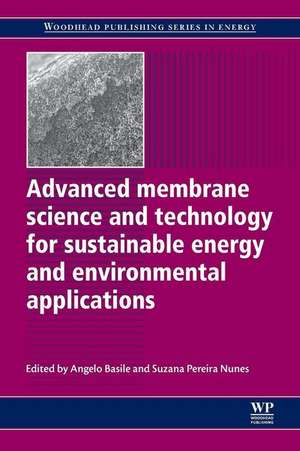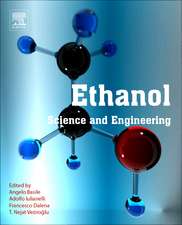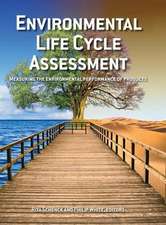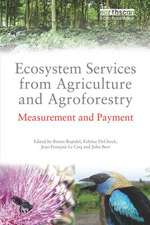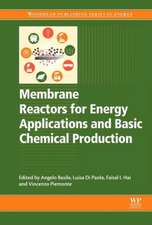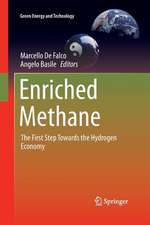Advanced Membrane Science and Technology for Sustainable Energy and Environmental Applications: Woodhead Publishing Series in Energy
Editat de Angelo Basile, Suzana Pereira Nunesen Limba Engleză Paperback – 19 aug 2016
Part one introduces the topic of membrane science and engineering, from the fundamentals of membrane processes and separation to membrane characterization and economic analysis. Part two focuses on membrane utilisation for carbon dioxide (CO2) capture in coal and gas power plants, including pre- and post-combustion and oxygen transport technologies. Part three reviews membranes for the petrochemical industry, with chapters covering hydrocarbon fuel, natural gas and synthesis gas processing, as well as advanced biofuels production. Part four covers membranes for alternative energy applications and energy storage, such as membrane technology for redox and lithium batteries, fuel cells and hydrogen production. Finally, part five discusses membranes utilisation in industrial and environmental applications, including microfiltration, ultrafiltration, and forward osmosis, as well as water, wastewater and nuclear power applications.
With its distinguished editors and team of expert contributors, Advanced membrane science and technology for sustainable energy and environmental applications is an essential reference for membrane and materials engineers and manufacturers, as well as researchers and academics interested in this field.
- Presents a comprehensive review of membrane science and technology, focusing on developments and applications in sustainable energy and clean-industry
- Discusses the fundamentals of membrane processes and separation and membrane characterization and economic analysis
- Addresses the key issues of membrane utilisation in coal and gas power plants and the petrochemical industry, the use of membranes for alternative energy applications and membrane utilisation in industrial and environmental applications
Din seria Woodhead Publishing Series in Energy
-
 Preț: 853.22 lei
Preț: 853.22 lei - 24%
 Preț: 1209.19 lei
Preț: 1209.19 lei - 24%
 Preț: 1307.96 lei
Preț: 1307.96 lei - 24%
 Preț: 1386.95 lei
Preț: 1386.95 lei - 9%
 Preț: 900.25 lei
Preț: 900.25 lei - 9%
 Preț: 1067.83 lei
Preț: 1067.83 lei - 29%
 Preț: 1071.46 lei
Preț: 1071.46 lei - 9%
 Preț: 950.40 lei
Preț: 950.40 lei - 9%
 Preț: 1011.50 lei
Preț: 1011.50 lei - 29%
 Preț: 1071.13 lei
Preț: 1071.13 lei - 9%
 Preț: 1309.35 lei
Preț: 1309.35 lei - 39%
 Preț: 1047.65 lei
Preț: 1047.65 lei - 9%
 Preț: 949.23 lei
Preț: 949.23 lei - 24%
 Preț: 1688.64 lei
Preț: 1688.64 lei - 9%
 Preț: 1344.70 lei
Preț: 1344.70 lei - 9%
 Preț: 1049.56 lei
Preț: 1049.56 lei - 27%
 Preț: 1937.44 lei
Preț: 1937.44 lei - 23%
 Preț: 1519.01 lei
Preț: 1519.01 lei - 23%
 Preț: 1074.68 lei
Preț: 1074.68 lei - 29%
 Preț: 981.24 lei
Preț: 981.24 lei - 9%
 Preț: 1397.24 lei
Preț: 1397.24 lei - 39%
 Preț: 1397.48 lei
Preț: 1397.48 lei - 9%
 Preț: 945.89 lei
Preț: 945.89 lei - 9%
 Preț: 1073.87 lei
Preț: 1073.87 lei - 9%
 Preț: 1514.09 lei
Preț: 1514.09 lei - 9%
 Preț: 1020.23 lei
Preț: 1020.23 lei - 39%
 Preț: 880.81 lei
Preț: 880.81 lei - 9%
 Preț: 950.94 lei
Preț: 950.94 lei - 9%
 Preț: 1214.08 lei
Preț: 1214.08 lei - 39%
 Preț: 1085.98 lei
Preț: 1085.98 lei - 9%
 Preț: 868.43 lei
Preț: 868.43 lei - 24%
 Preț: 1615.93 lei
Preț: 1615.93 lei - 31%
 Preț: 927.68 lei
Preț: 927.68 lei - 24%
 Preț: 1077.86 lei
Preț: 1077.86 lei - 9%
 Preț: 946.04 lei
Preț: 946.04 lei - 9%
 Preț: 952.05 lei
Preț: 952.05 lei - 9%
 Preț: 1165.33 lei
Preț: 1165.33 lei - 24%
 Preț: 1307.96 lei
Preț: 1307.96 lei - 29%
 Preț: 1213.47 lei
Preț: 1213.47 lei - 24%
 Preț: 1075.25 lei
Preț: 1075.25 lei - 24%
 Preț: 1048.44 lei
Preț: 1048.44 lei - 29%
 Preț: 1454.22 lei
Preț: 1454.22 lei - 39%
 Preț: 1285.27 lei
Preț: 1285.27 lei - 9%
 Preț: 952.68 lei
Preț: 952.68 lei - 23%
 Preț: 878.04 lei
Preț: 878.04 lei - 9%
 Preț: 951.98 lei
Preț: 951.98 lei - 9%
 Preț: 1209.42 lei
Preț: 1209.42 lei - 9%
 Preț: 1233.82 lei
Preț: 1233.82 lei
Preț: 1225.96 lei
Preț vechi: 1995.60 lei
-39% Nou
Puncte Express: 1839
Preț estimativ în valută:
234.61€ • 243.45$ • 196.10£
234.61€ • 243.45$ • 196.10£
Carte tipărită la comandă
Livrare economică 08-22 martie
Preluare comenzi: 021 569.72.76
Specificații
ISBN-13: 9780081016909
ISBN-10: 0081016905
Pagini: 848
Dimensiuni: 156 x 234 x 43 mm
Greutate: 1.17 kg
Editura: ELSEVIER SCIENCE
Seria Woodhead Publishing Series in Energy
ISBN-10: 0081016905
Pagini: 848
Dimensiuni: 156 x 234 x 43 mm
Greutate: 1.17 kg
Editura: ELSEVIER SCIENCE
Seria Woodhead Publishing Series in Energy
Cuprins
Contributor contact details
Woodhead Publishing Series in Energy
Preface
Part I: Introduction to membrane science and engineering
Chapter 1: Fundamental membrane processes, science and engineering
Abstract:
1.1 Introduction
1.2 Membrane processes
1.3 Conclusions and future trends
Chapter 2: Fundamental science of gas and vapour separation in polymeric membranes
Abstract:
2.1 Introduction
2.2 Basic principles and definitions of separation processes
2.3 Effects of the properties of penetrants and polymers
2.4 Effects of pressure on transport parameters
2.5 Effects of temperature on transport parameters
2.6 Gas permeability of polymers: objects of membrane gas separation
2.8 Appendix: list of symbols
Chapter 3: Characterization of membranes for energy and environmental applications
Abstract:
3.1 Polymer and carbon molecular sieve membranes
3.2 Zeolite and mixed matrix membranes
3.3 Mass transport characterization
3.4 Conclusions
3.6 Appendix: list of symbols
Chapter 4: Economic analysis of membrane use in industrial applications
Abstract:
4.1 Introduction
4.2 Economic analysis
4.3 Case studies
4.4 Conclusions and future trends
Part II: Membranes for coal and gas power plants: carbon dioxide (CO2) capture, synthesis gas processing and oxygen (O2) transport
Chapter 5: Membrane technology for carbon dioxide (CO2) capture in power plants
Abstract:
5.1 Introduction
5.2 Reasons for using membranes for carbon dioxide (CO2) separation and sequestration
5.3 A short review of membrane technology for CO2 separation
5.4 Performance of membrane processes for CO2 sequestration
5.5 Membrane modules for CO2 sequestration
5.6 Design for power plant integration
5.7 Cost considerations and membrane technology at the industrial scale
5.8 Modelling aspects of gas permeation membrane modules
5.9 Conclusions and future trends
5.11 Appendix: list of symbols
Chapter 6: Polymeric membranes for post-combustion carbon dioxide (CO2) capture
Abstract:
6.1 Introduction
6.2 Basic principles of flue gas membrane separation
6.3 Membrane development and applications in power plants
6.4 Operation and performance issues and analysis
6.5 Advantages and limitations
6.6 Future trends
Chapter 7: Inorganic membranes for pre-combustion carbon dioxide (CO2) capture
Abstract:
7.1 Introduction
7.2 Inorganic membranes for carbon dioxide (CO2) separation
7.3 Membrane reactors for CO2 capture
7.4 Techno-economic analysis of the integrated gasification combined cycle (IGCC) and natural gas combined cycle (NGCC)
7.5 Conclusions and future trends
Chapter 8: Inorganic membranes for synthesis gas processing
Abstract:
8.1 Introduction
8.2 Basic principles of membrane operation
8.3 Membrane materials and development
8.4 Application and integration in industry
8.5 Membrane modules
8.6 Future trends
8.7 Conclusions
8.9 Appendix: list of symbols
Chapter 9: Oxygen transport membranes: dense ceramic membranes for power plant applications
Abstract:
9.1 Introduction
9.2 Oxygen transport membrane materials, development and design
9.3 Principles of oxygen membrane separation
9.4 Application and integration in power plants
9.5 Oxygen transport membranes
9.6 Future trends
9.7 Conclusions
9.8 Acknowledgements
Part III: Membranes for the petrochemical industry: hydrocarbon fuel and natural gas processing, and advanced biofuels production
Chapter 10: Membranes for hydrocarbon fuel processing and separation
Abstract:
10.1 Introduction
10.2 Membrane materials, development and design for hydrocarbon processing
10.3 Separation of olefins and paraffins
10.4 Removal of hydrocarbons from liquid streams
10.5 Nanotechnologies from fundamental research to large-scale industry
10.7 Appendix: list of symbols
Chapter 11: Polymeric membranes for natural gas processing
Abstract:
11.1 Introduction
11.2 Polymeric membrane operations in natural gas processing
11.3 Membrane materials, development and design for natural gas processing
11.4 Operation and performance issues and analysis
11.5 Application and integration into natural gas operations
11.6 Advantages and limitations
11.7 Future trends
11.10 Appendix: list of symbols
Chapter 12: Membranes for advanced biofuels production
Abstract:
12.1 General overview of second-generation biofuels
12.2 Hydrolysis of biomass to produce sugars
12.3 Key role of process engineering for second-generation biofuels production
12.4 Membrane bioreactors
12.5 Biocatalyst continuously separated by a membrane system and recirculated into the reaction tank
12.6 Biocatalyst immobilized onto the membrane surface
12.7 Continuous stirred tank reactor with biocatalyst immobilized on the membrane surface (CSTMB)
12.8 Single pass membrane bioreactor
12.9 Hollow fibre membrane bioreactor with recycling of unreacted substrate
12.10 Conclusions
12.13 Appendix: list of symbols
Part IV: Membranes for alternative energy applications: batteries, fuel cells and hydrogen (H2) production
Chapter 13: Ion exchange membranes for vanadium redox flow batteries
Abstract:
13.1 Electrochemical energy storage
13.2 Vanadium redox flow batteries
13.3 Membranes
13.4 Conclusions
Chapter 14: Membranes for lithium batteries
Abstract:
14.1 Introduction
14.2 Types of lithium battery and basic operating principles
14.3 Polymer electrolyte membranes for advanced lithium batteries
14.4 Conclusions and future trends
Chapter 15: Proton exchange membranes for fuel cells
Abstract:
15.1 Introduction
15.2 Basic operating principles and types of fuel cell
15.3 Membrane materials, design and fabrication processes
15.4 Membrane performance in operation: issues and analysis
15.5 Integration and application of proton exchange membrane (PEM) fuel cell systems
15.6 Advantages and limitations of PEM fuel cells
15.7 Future trends
15.10 Appendix: list of symbols
Chapter 16: Functional ceramic hollow fibre membranes for catalytic membrane reactors and solid oxide fuel cells
Abstract:
16.1 Introduction
16.2 Membrane materials issues
16.3 Membrane development routes and macrostructure control
16.4 A multifunctional dual-layer hollow fibre membrane reactor (DL-HFMR) for methane conversion
16.5 Dual-layer hollow fibres for a micro-tubular solid oxide fuel cell (SOFC)
16.6 Other ways of improving ceramic dual-layer hollow fibres
16.7 Conclusions
Chapter 17: Proton-conducting ceramic membranes for solid oxide fuel cells and hydrogen (H2) processing
Abstract:
17.1 Introduction
17.2 Operation principle of proton-conducting ceramic membranes and demands on materials
17.3 Protons and proton conductance in ceramics
17.4 Conductivity and hydrogen (H2) flux of selected classes of ceramic membrane materials
17.5 Structure of selected classes of proton-conducting materials
17.6 Chemical stability of selected classes of ceramic membrane materials
17.7 Conclusions
17.8 Acknowledgements
Chapter 18: Membrane electrolysers for hydrogen (H2) production
Abstract:
18.1 Introduction
18.2 Basic principles of electrolysis
18.3 Membrane materials
18.4 Membrane performance
18.5 Application and integration of electrolyser systems
18.6 Some advantages and limitations of current membrane materials
18.7 Future trends
18.10 Appendix: nomenclature
Chapter 19: Biomimetic membrane reactors for hydrogen (H2) production
Abstract:
19.1 Introduction
19.2 General background to the concept
19.3 An ambitious goal with numerous challenges
19.4 Thermodynamic limitations and device design
19.5 Integrated engineering approach for solar-to-fuel conversion
19.6 Conclusions
Part V: Membranes for industrial, environmental and nuclear applications
Chapter 20: Membranes for industrial microfiltration and ultrafiltration
Abstract:
20.1 Introduction
20.2 Basic principles of microfiltration and ultrafiltration
20.3 Membrane materials and membrane preparation technology
20.4 Module configuration and process design
20.5 Concentration polarization and membrane fouling
20.6 Applications
20.7 Microfiltration and ultrafiltration in integrated processes
20.8 Advantages and limitations
20.9 Future trends
Chapter 21: Membranes for forward osmosis in industrial applications
Abstract:
21.1 Introduction
21.2 Mechanism of forward osmosis
21.3 Membranes for forward osmosis
21.4 Forward osmosis membrane modules
21.5 Effect of various parameters on transmembrane flux
21.6 Applications of forward osmosis
21.7 Conclusions
21.8 Acknowledgements
Chapter 22: Degradation of polymeric membranes in water and wastewater treatment
Abstract:
22.1 Introduction
22.2 Polymer materials and module design
22.3 Membrane failure and operational issues
22.4 Membrane degradation mechanisms
22.5 Identification and monitoring of membrane degradation
22.6 Materials degradation control strategies
22.7 Future trends
22.9 Acknowledgements
Chapter 23: Membranes for photocatalysis in water and wastewater treatment
Abstract:
23.1 Introduction
23.2 Basic principles of heterogeneous photocatalysis
23.3 Membrane materials developments and design for photocatalysis
23.4 Membrane operations performance issues and analysis: case studies
23.5 Future trends
Chapter 24: Membranes for nuclear power applications
Abstract:
24.1 Introduction
24.2 Membranes for nuclear fission applications
24.3 Membranes for nuclear fusion applications
24.4 Conclusions
24.5 Future trends
Index
Woodhead Publishing Series in Energy
Preface
Part I: Introduction to membrane science and engineering
Chapter 1: Fundamental membrane processes, science and engineering
Abstract:
1.1 Introduction
1.2 Membrane processes
1.3 Conclusions and future trends
Chapter 2: Fundamental science of gas and vapour separation in polymeric membranes
Abstract:
2.1 Introduction
2.2 Basic principles and definitions of separation processes
2.3 Effects of the properties of penetrants and polymers
2.4 Effects of pressure on transport parameters
2.5 Effects of temperature on transport parameters
2.6 Gas permeability of polymers: objects of membrane gas separation
2.8 Appendix: list of symbols
Chapter 3: Characterization of membranes for energy and environmental applications
Abstract:
3.1 Polymer and carbon molecular sieve membranes
3.2 Zeolite and mixed matrix membranes
3.3 Mass transport characterization
3.4 Conclusions
3.6 Appendix: list of symbols
Chapter 4: Economic analysis of membrane use in industrial applications
Abstract:
4.1 Introduction
4.2 Economic analysis
4.3 Case studies
4.4 Conclusions and future trends
Part II: Membranes for coal and gas power plants: carbon dioxide (CO2) capture, synthesis gas processing and oxygen (O2) transport
Chapter 5: Membrane technology for carbon dioxide (CO2) capture in power plants
Abstract:
5.1 Introduction
5.2 Reasons for using membranes for carbon dioxide (CO2) separation and sequestration
5.3 A short review of membrane technology for CO2 separation
5.4 Performance of membrane processes for CO2 sequestration
5.5 Membrane modules for CO2 sequestration
5.6 Design for power plant integration
5.7 Cost considerations and membrane technology at the industrial scale
5.8 Modelling aspects of gas permeation membrane modules
5.9 Conclusions and future trends
5.11 Appendix: list of symbols
Chapter 6: Polymeric membranes for post-combustion carbon dioxide (CO2) capture
Abstract:
6.1 Introduction
6.2 Basic principles of flue gas membrane separation
6.3 Membrane development and applications in power plants
6.4 Operation and performance issues and analysis
6.5 Advantages and limitations
6.6 Future trends
Chapter 7: Inorganic membranes for pre-combustion carbon dioxide (CO2) capture
Abstract:
7.1 Introduction
7.2 Inorganic membranes for carbon dioxide (CO2) separation
7.3 Membrane reactors for CO2 capture
7.4 Techno-economic analysis of the integrated gasification combined cycle (IGCC) and natural gas combined cycle (NGCC)
7.5 Conclusions and future trends
Chapter 8: Inorganic membranes for synthesis gas processing
Abstract:
8.1 Introduction
8.2 Basic principles of membrane operation
8.3 Membrane materials and development
8.4 Application and integration in industry
8.5 Membrane modules
8.6 Future trends
8.7 Conclusions
8.9 Appendix: list of symbols
Chapter 9: Oxygen transport membranes: dense ceramic membranes for power plant applications
Abstract:
9.1 Introduction
9.2 Oxygen transport membrane materials, development and design
9.3 Principles of oxygen membrane separation
9.4 Application and integration in power plants
9.5 Oxygen transport membranes
9.6 Future trends
9.7 Conclusions
9.8 Acknowledgements
Part III: Membranes for the petrochemical industry: hydrocarbon fuel and natural gas processing, and advanced biofuels production
Chapter 10: Membranes for hydrocarbon fuel processing and separation
Abstract:
10.1 Introduction
10.2 Membrane materials, development and design for hydrocarbon processing
10.3 Separation of olefins and paraffins
10.4 Removal of hydrocarbons from liquid streams
10.5 Nanotechnologies from fundamental research to large-scale industry
10.7 Appendix: list of symbols
Chapter 11: Polymeric membranes for natural gas processing
Abstract:
11.1 Introduction
11.2 Polymeric membrane operations in natural gas processing
11.3 Membrane materials, development and design for natural gas processing
11.4 Operation and performance issues and analysis
11.5 Application and integration into natural gas operations
11.6 Advantages and limitations
11.7 Future trends
11.10 Appendix: list of symbols
Chapter 12: Membranes for advanced biofuels production
Abstract:
12.1 General overview of second-generation biofuels
12.2 Hydrolysis of biomass to produce sugars
12.3 Key role of process engineering for second-generation biofuels production
12.4 Membrane bioreactors
12.5 Biocatalyst continuously separated by a membrane system and recirculated into the reaction tank
12.6 Biocatalyst immobilized onto the membrane surface
12.7 Continuous stirred tank reactor with biocatalyst immobilized on the membrane surface (CSTMB)
12.8 Single pass membrane bioreactor
12.9 Hollow fibre membrane bioreactor with recycling of unreacted substrate
12.10 Conclusions
12.13 Appendix: list of symbols
Part IV: Membranes for alternative energy applications: batteries, fuel cells and hydrogen (H2) production
Chapter 13: Ion exchange membranes for vanadium redox flow batteries
Abstract:
13.1 Electrochemical energy storage
13.2 Vanadium redox flow batteries
13.3 Membranes
13.4 Conclusions
Chapter 14: Membranes for lithium batteries
Abstract:
14.1 Introduction
14.2 Types of lithium battery and basic operating principles
14.3 Polymer electrolyte membranes for advanced lithium batteries
14.4 Conclusions and future trends
Chapter 15: Proton exchange membranes for fuel cells
Abstract:
15.1 Introduction
15.2 Basic operating principles and types of fuel cell
15.3 Membrane materials, design and fabrication processes
15.4 Membrane performance in operation: issues and analysis
15.5 Integration and application of proton exchange membrane (PEM) fuel cell systems
15.6 Advantages and limitations of PEM fuel cells
15.7 Future trends
15.10 Appendix: list of symbols
Chapter 16: Functional ceramic hollow fibre membranes for catalytic membrane reactors and solid oxide fuel cells
Abstract:
16.1 Introduction
16.2 Membrane materials issues
16.3 Membrane development routes and macrostructure control
16.4 A multifunctional dual-layer hollow fibre membrane reactor (DL-HFMR) for methane conversion
16.5 Dual-layer hollow fibres for a micro-tubular solid oxide fuel cell (SOFC)
16.6 Other ways of improving ceramic dual-layer hollow fibres
16.7 Conclusions
Chapter 17: Proton-conducting ceramic membranes for solid oxide fuel cells and hydrogen (H2) processing
Abstract:
17.1 Introduction
17.2 Operation principle of proton-conducting ceramic membranes and demands on materials
17.3 Protons and proton conductance in ceramics
17.4 Conductivity and hydrogen (H2) flux of selected classes of ceramic membrane materials
17.5 Structure of selected classes of proton-conducting materials
17.6 Chemical stability of selected classes of ceramic membrane materials
17.7 Conclusions
17.8 Acknowledgements
Chapter 18: Membrane electrolysers for hydrogen (H2) production
Abstract:
18.1 Introduction
18.2 Basic principles of electrolysis
18.3 Membrane materials
18.4 Membrane performance
18.5 Application and integration of electrolyser systems
18.6 Some advantages and limitations of current membrane materials
18.7 Future trends
18.10 Appendix: nomenclature
Chapter 19: Biomimetic membrane reactors for hydrogen (H2) production
Abstract:
19.1 Introduction
19.2 General background to the concept
19.3 An ambitious goal with numerous challenges
19.4 Thermodynamic limitations and device design
19.5 Integrated engineering approach for solar-to-fuel conversion
19.6 Conclusions
Part V: Membranes for industrial, environmental and nuclear applications
Chapter 20: Membranes for industrial microfiltration and ultrafiltration
Abstract:
20.1 Introduction
20.2 Basic principles of microfiltration and ultrafiltration
20.3 Membrane materials and membrane preparation technology
20.4 Module configuration and process design
20.5 Concentration polarization and membrane fouling
20.6 Applications
20.7 Microfiltration and ultrafiltration in integrated processes
20.8 Advantages and limitations
20.9 Future trends
Chapter 21: Membranes for forward osmosis in industrial applications
Abstract:
21.1 Introduction
21.2 Mechanism of forward osmosis
21.3 Membranes for forward osmosis
21.4 Forward osmosis membrane modules
21.5 Effect of various parameters on transmembrane flux
21.6 Applications of forward osmosis
21.7 Conclusions
21.8 Acknowledgements
Chapter 22: Degradation of polymeric membranes in water and wastewater treatment
Abstract:
22.1 Introduction
22.2 Polymer materials and module design
22.3 Membrane failure and operational issues
22.4 Membrane degradation mechanisms
22.5 Identification and monitoring of membrane degradation
22.6 Materials degradation control strategies
22.7 Future trends
22.9 Acknowledgements
Chapter 23: Membranes for photocatalysis in water and wastewater treatment
Abstract:
23.1 Introduction
23.2 Basic principles of heterogeneous photocatalysis
23.3 Membrane materials developments and design for photocatalysis
23.4 Membrane operations performance issues and analysis: case studies
23.5 Future trends
Chapter 24: Membranes for nuclear power applications
Abstract:
24.1 Introduction
24.2 Membranes for nuclear fission applications
24.3 Membranes for nuclear fusion applications
24.4 Conclusions
24.5 Future trends
Index
